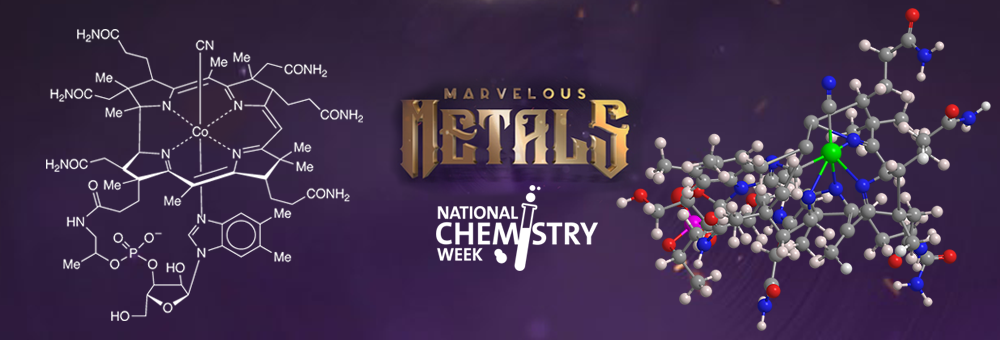What molecule am I?

The theme for this year’s National Chemistry Week is Marvelous Metals. One reason that metals are marvelous is that many of them can combine with organic structures to make organometallic compounds that are essential for life.
One example is former Molecule of the Week chlorophyll, in which the metal is magnesium. This week’s molecule, vitamin B12, contains a cobalt atom, a rarity in natural products.
The basic vitamin B12 structure has several chemical forms that differ by the substituent on the central cobalt atom. The one shown in the images, with a cyanide group bonded to cobalt, goes by the name cyanocobalamin. It is a manufactured form of the vitamin that is made from natural forms and used in supplements because it is highly bioavailable.
Vitamin B12 has an extensive history. Some highlights:
- 1849–1947: Once pernicious anemia was identified, it was found to respond well to liver extracts, which were then used for treatment.
- 1948: Mary Shaw Shorb at the University of Maryland (College Park), Karl A. Folkers at Merck (then in Rahway, NJ), and colleagues isolated vitamin B12 from several sources, including liver.
- 1956: Crystallographer Dorothy Crowfoot Hodgkin at Oxford University (UK) determined the structure of vitamin B12.
- 1973: Robert B. Woodward at Harvard University (Cambridge, MA), Albert Eschenmoser at the Swiss Federal Institute of Technology in Zurich (ETH Zurich), and almost 100 co-workers completed the total synthesis of the vitamin.
Hodgkin received the 1964 Nobel Prize in Chemistry for her structure studies on vitamin B12 and other complex molecules. Woodward and Eschenmoser had been awarded earlier Nobels for their achievements in natural product synthesis.
Vitamin B12 is found in every cell in the body and has multiple functions, including acting as a cofactor in DNA synthesis. Animal-based foods (meat, milk, and eggs) are the primary sources; vegetarians, especially vegans, must include plant- or bacterium-derived vitamin B12 supplements in their diets.
Vitamin B12 is indeed a molecule to celebrate during National Chemistry Week!
Vitamin B12 hazard information
| GHS classification*: not a hazardous substance or mixture |
*Globally Harmonized System of Classification and Labeling of Chemicals.
Vitamin B12 fast facts
| CAS Reg. No. | 68-19-9 |
| Empirical formula | C63H88CoN14O14P |
| Molar mass | 1355.36 g/mol |
| Appearance | Dark red crystals or red powder |
| Melting point | >300 ºC |
| Water solubility | 12.5 g/L |

Learn more about this molecule from CAS, the most authoritative and comprehensive source for chemical information.
Molecule of the Week needs your suggestions!
If your favorite molecule is not in our archive, please send us a message. The molecule can be notable for its current or historical importance or for any quirky reason. Thank you!
Stay Ahead of the Chemistry Curve
Learn how ACS can help you stay ahead in the world of chemistry.

